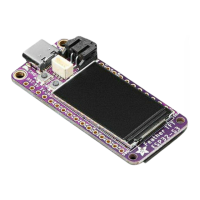There is a power pin that must be pulled high for the display to work. This is done
automatically by CircuitPython and Arduino. The pin is available in CircuitPython and
in Arduino as TFT_I2C_POWER .
ESP32-S3 WiFi Module
This is the ESP32-S3 module.
The ESP32-S3 is a highly-integrated, low-power, 2.4 GHz Wi-Fi/BLE System-on-Chip
(SoC) solution thathasbuilt-in native USBas well as some other interesting new
technologies like Time of Flight distance measurements and AI acceleration. With its
state-of-the-art power and RF performance, this SoC is an ideal choice for a wide
variety of application scenarios relating to theInternet of Things (IoT)(),wearable
electronics(), and smart homes.
The Feather ESP32-S3 has a dual-core 240 MHz chip, so it is comparable to ESP32's
dual-core. However, there is no BluetoothClassicsupport, only Bluetooth LE. This
chip is a great step up from the earlier ESP32-S2! This ESP32-S3 mini-module we are
using on the Feather comes with 4MB flash and 2 MB PSRAM, as well as 512KB of
SRAM, so it's perfect for use with CircuitPython support or any time massive buffers
are needed: for fast memory access use SRAM, for slower-but-roomier access use
PSRAM. It's also great for use in ESP-IDF or with Arduino support.
The 4 MB of flash is inside the module and is used for both program firmware and
filesystem storage. For example, in CircuitPython, we have 3 MB set aside for program
If you run into I2C or TFT power issues on Arduino, ensure you are using the
latest Espressif board support package. If you are still having issues, you may
need to manually pull the pin HIGH in your code.
©Adafruit Industries Page 16 of 263

